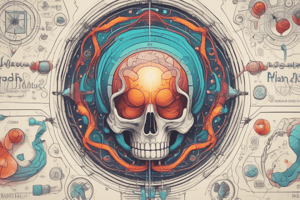Podcast
Questions and Answers
What is the primary function of analgesics?
What is the primary function of analgesics?
- To eliminate the noxious stimulus
- To intensify the sensation of pain
- To reduce distress associated with pain (correct)
- To induce a state of anesthesia
What type of pain is characterized by an aberration of the normal physiological pathway?
What type of pain is characterized by an aberration of the normal physiological pathway?
- Chronic pain (correct)
- Acute pain
- Hyperalgesic pain
- Nociceptive pain
Which type of nerve fibre is responsible for conveying sharp, well-localized pain?
Which type of nerve fibre is responsible for conveying sharp, well-localized pain?
- Aβ fibres
- Aδ fibres (correct)
- Aα fibres
- C fibres
What is the result of the activation of nociceptive neurons?
What is the result of the activation of nociceptive neurons?
What is the primary difference between nociception and pain?
What is the primary difference between nociception and pain?
What is the primary mechanism by which opioids produce analgesia?
What is the primary mechanism by which opioids produce analgesia?
What type of receptors are opioid receptors classified as?
What type of receptors are opioid receptors classified as?
What is characterized by the requirement of increasingly higher doses of a drug to produce a given pharmacological effect?
What is characterized by the requirement of increasingly higher doses of a drug to produce a given pharmacological effect?
What is the term for the withdrawal symptoms that occur when an individual stops taking an opioid drug?
What is the term for the withdrawal symptoms that occur when an individual stops taking an opioid drug?
What type of pain is often resistant to conventional analgesics and is associated with neurological disease?
What type of pain is often resistant to conventional analgesics and is associated with neurological disease?
Allodyria is a type of pain that is characterized by an intense and unpleasant sensation in response to an excessive noxious stimulus.
Allodyria is a type of pain that is characterized by an intense and unpleasant sensation in response to an excessive noxious stimulus.
C fibres are myelinated nerve fibres that convey sharp, well-localized pain.
C fibres are myelinated nerve fibres that convey sharp, well-localized pain.
Bradykinin is a neurotransmitter that is involved in the inhibition of nociceptive neurons.
Bradykinin is a neurotransmitter that is involved in the inhibition of nociceptive neurons.
The dorsal horn is a structure in the peripheral nerve terminal where nociceptive neurons are activated.
The dorsal horn is a structure in the peripheral nerve terminal where nociceptive neurons are activated.
The.rostroventral medulla is involved in descending inhibitory controls.
The.rostroventral medulla is involved in descending inhibitory controls.
Enkephalins are found in the peripheral sensory neurons.
Enkephalins are found in the peripheral sensory neurons.
Opioid receptors are classified as Gs receptors.
Opioid receptors are classified as Gs receptors.
Nausea and vomiting are associated with opioid use.
Nausea and vomiting are associated with opioid use.
Neuropathic pain is typically responsive to conventional analgesics.
Neuropathic pain is typically responsive to conventional analgesics.
Flashcards are hidden until you start studying
Study Notes
Pain and Analgesics
- Pain is a subjective experience, a direct response to an untoward event associated with tissue damage, and is characterized by nociception, the perception of noxious stimuli.
- Analgesics aim to reduce the distress associated with pain, not just its antinociceptive effects.
Types of Pain
- Acute pain: an intense and unpleasant sensation resulting from an excessive noxious stimulus.
- Chronic pain: aberrations of the normal physiological pathway, often accompanied by:
- Hyperalgesia: increased pain in response to a mild noxious stimulus.
- Allodyria: pain evoked by a non-noxious stimulus.
- Spontaneous pain: pain without an apparent stimulus.
Nociceptive Afferent Pathway
- Pain is transmitted through impulse activity in small-diameter primary afferent fibers of peripheral nerves, which have sensory endings.
- C fibers (unmyelinated) have polymodal nociceptive endings, conveying dull, diffuse, burning pain.
- Aδ fibers (myelinated) convey sharp, well-localized pain.
Modulation in the Nociceptive Pathway
- Transmission of pain to higher centers involves descending inhibitory controls, including:
- Amygdala
- Insular cortex
- Hypothalamus
- Periaqueductal grey
- Rostroventral medulla
- Substantia gelatinosa
Analgesic Drugs (Opioids)
- Opioids are derived from opium, an extract from poppy juice, and contain morphine.
- Opioid receptors include μ, δ, κ, and ORL, which are widely distributed in the brain, spinal cord, and peripheral sensory neurons.
- Endogenous ligands for opioid receptors include endorphins.
Mechanism of Action (Opioids)
- Opioids act on the CNS, producing:
- Analgesia
- Euphoria
- Respiratory depression
- Depression of the cough reflex
- Nausea and vomiting
- Pupillary constriction
- GI tract effects
- Other actions
Tolerance and Dependence
- Tolerance: increased dose required to produce a given pharmacological effect, partly due to desensitization of μ receptors.
- Physical dependence: withdrawal causes adverse physiological effects, such as irritability, aggression, shakes, and writhing.
Neuropathic Pain
- Neuropathic pain is associated with neurological disease, unrelated to peripheral tissue injury.
- It is often linked to conditions like stroke, multiple sclerosis, peripheral diabetic neuropathy, and shingles.
- Pathophysiology is poorly understood, and conventional analgesics may be ineffective, making it opioid-resistant.
Studying That Suits You
Use AI to generate personalized quizzes and flashcards to suit your learning preferences.




